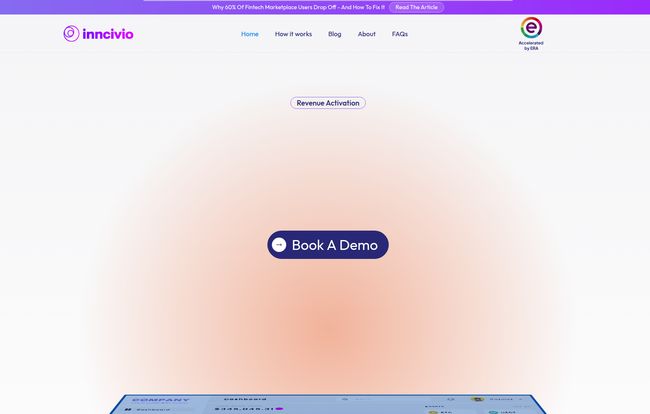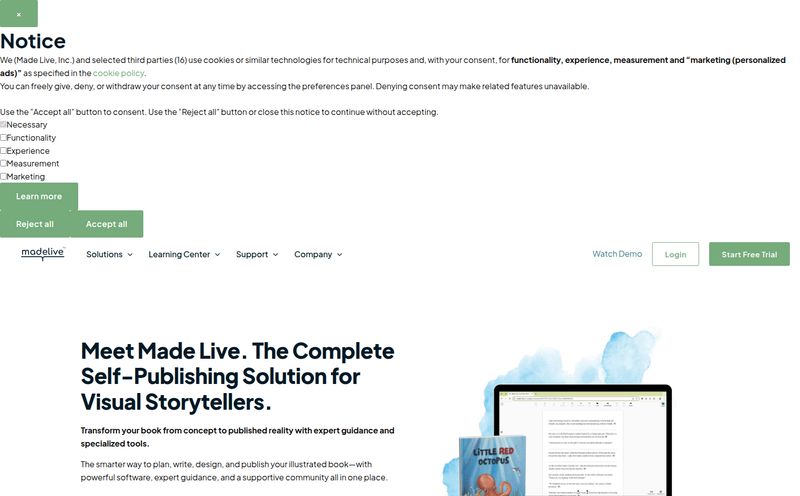For years, we in the growth and SEO world have been obsessed with one thing: acquisition. How many clicks can we get? What’s our CPC? How can we get our cost per install down by another three cents? We pour money into Google Ads, fancy influencer campaigns, and slick app store optimization. And it works. People download our apps.
And then… crickets.
This is the dirty little secret of the fintech industry. It’s a leaky bucket. A very, very expensive leaky bucket. I’ve seen the analytics of enough startups to know. You spend a fortune getting users in the door, and they wander around aimlessly for a few minutes before quietly slipping out the back, never to be seen again. According to some data I saw on inncivio's site, a staggering 60% of fintech marketplace users drop off. Ouch. That stings because it feels true.
So when I came across a platform called inncivio, my curiosity was definitely piqued. They’re not talking about acquisition. They’re talking about what happens after the download. They’re talking about activation and engagement. And they're using AI to do it. This, I had to look into.
So, What on Earth is inncivio Anyway?
At first glance, you might think, “Oh, another chatbot or onboarding tool.” But that’s not quite right. It's more sophisticated than that. Think of inncivio as an intelligence layer you embed directly into your fintech platform. It’s not a pop-up; it's part of the furniture. Its job is to provide personalized, real-time guidance to your users right when they need it most.
Imagine your user is on a trading app, staring at a complex options screen for the first time. They’re confused. They’re about to give up and just go back to buying index funds. But right at that moment, a small, contextual tip appears, explaining what “strike price” means in simple terms. Not a generic FAQ link, but a tailored piece of micro-education. That’s the idea here.
It's meant to bridge the gap between a user Googling a term (and probably getting distracted by Reddit) and needing expensive one-on-one coaching. It’s like having a tiny, hyper-competent financial mentor built into your app’s DNA.

Visit inncivio
The Core Problem inncivio Is Built To Solve
The fundamental challenge is turning a passive user into an active one. Someone can have your crypto exchange app on their phone for months, but if they never get past the verification stage or make that first small trade, are they really a user? Not in any way that matters to your bottom line.
Generic onboarding flows—those “click here, now click here” tutorials—are a bit 2015. They treat every user the same. But my journey as a complete crypto novice is wildly different from that of a seasoned DeFi trader. Innivcio seems to get this. They’re focused on the moments of hesitation and confusion that cause users to churn. By providing the right nudge at the right time, the goal is to build confidence and guide them toward those key “aha!” moments that create a loyal, revenue-generating customer.
How It Works: The Magic Under the Hood
This isn't just a set of pre-written tooltips. The whole system is built on a few clever principles.
Behavior-Driven Personalization
This is the secret sauce, in my opinion. Innivcio watches how users interact with your platform. Are they lingering on a certain screen? Did they start a process but not finish it? Based on this behavior, it delivers a specific piece of content. It’s reactive. This is a world away from a one-size-fits-all approach. It's the difference between a town crier shouting the same news to everyone and a personal assistant whispering exactly what you need to hear.
Real-Time Micro-Education
We’re all drowning in information. The last thing a user wants is to be sent to a 50-page knowledge base to find one simple answer. Innivcio is built for the short-attention-span economy. It delivers tiny, digestible bits of information—micro-education—precisely when and where it's needed. This lowers friction and helps users learn by doing, which is infinitely more effective.
Continuous AI Optimization
Here’s the part that made the ops guy in me smile. The platform claims “zero manual updates.” It uses its AI, which they mention is backed by powerful tech like Llama 2 and hosted on AWS, to continuously learn what works. It's A/B testing its own suggestions, refining its approach, and getting smarter over time without you having to manually tweak every single user flow. Remember what I said about the headache of manual updates? This is the aspirin.
What I Like About inncivio (The Upsides)
After digging around, a few things really stand out. First, the fintech-specific expertise is a massive plus. General-purpose tools don't understand the jargon or the unique user anxieties of finance. Innivcio is built by people who get the difference between a P/E ratio and an APR. That context is everything.
I also appreciate that the focus is squarely on increasing revenue per user. It’s not just about fluffy engagement metrics; it’s about turning users into profitable customers. It ties product experience directly to business goals, which is how it should be.
Finally, the promise of easy integration is always attractive. Of course, the devil is always in the details and the quality of the API documentation, but the intent to make it a low-lift process is clear.
A Few Things to Keep in Mind (The Reality Check)
Now, let’s be realists. This isn't a magic wand you just wave at your app. There are some practicalities to consider.
For one, its effectiveness is going to depend heavily on the quality of the data you feed it. The classic “garbage in, garbage out” principle applies. If your existing knowledge base is a mess or your user analytics are poorly defined, the AI will have a harder time being effective. You need a solid foundation.
Also, integration is still integration. Even if it's “easy,” it will require developer time and resources to get it embedded and configured correctly. It’s not a no-code tool you can set up over a coffee break. And you have to define your goals clearly. You can’t just turn it on and hope for the best; you need to tell the system what a “successful activation” or an “engaged user” actually looks like for your specific platform.
Let's Talk Money: inncivio Pricing
Ah, the question every business owner asks first. If you’re looking for a pricing page with neat little tiers, you wont find one. Innivcio uses a “Book a Demo” model.
Don’t let that scare you. This is pretty standard for specialized B2B SaaS platforms. It usually means the pricing is customized based on your number of users, the complexity of the integration, and the level of support you need. It’s not a one-size-fits-all product, so it doesn’t have a one-size-fits-all price. You’ll have to have a conversation with their team to get a quote.
Who is This Really For?
In my view, inncivio is tailor-made for a specific type of company. It's for established fintech platforms—think neobanks, trading platforms, crypto exchanges, and personal finance management tools—that have moved past the initial scramble for downloads and are now seriously focused on user lifetime value (LTV). It's for product managers and growth teams who are tired of seeing their user funnels leak like a sieve and understand that the real growth is in retention, not just acquisition.
If you're still at the stage of just trying to get your first 1,000 users, this might be overkill. But if you have traffic and are struggling to convert that traffic into a deeply engaged, active user base, then inncivio is definitely aiming to solve your exact problem.
My Final Thoughts
I’m cautiously optimistic about tools like inncivio. For too long, we’ve treated the user experience after the sign-up as an afterthought. We build powerful platforms and then just… hope users figure them out. That’s clearly not working.
Inncivio represents a shift from passive onboarding to active, intelligent guidance. It’s about building a smarter, more responsive relationship with your users from within the app itself. It won’t solve all your problems, and it requires commitment to set up right. But tackling that 60% user drop-off? That’s a prize worth fighting for, and this looks like a pretty interesting new weapon for the fight.
Frequently Asked Questions
- What is inncivio in simple terms?
- Inncivio is an AI tool that integrates into fintech apps to give users personalized, real-time help and tips. It's like having a smart financial guide inside the app to reduce confusion and keep users engaged.
- How does inncivio help increase revenue?
- By guiding users through complex features and helping them achieve their goals (like making their first trade or setting up a savings plan), it increases user activation and confidence. Active, confident users are more likely to use paid features and become long-term, valuable customers.
- Is inncivio difficult to integrate into an existing platform?
- While it claims to have easy integration, any platform integration will require some developer resources. It's designed to work with existing knowledge bases and user data, but you should plan for a technical setup process.
- What kind of fintech companies can benefit from inncivio?
- It's ideal for a range of fintechs, including online trading platforms, cryptocurrency exchanges, neobanks, and personal finance management (PFM) apps that want to improve user retention and lifetime value.
- Does inncivio use my company's private data?
- Yes, it's designed to work with your existing knowledge base and user behavior data to provide personalization. Security and data privacy would be a key topic to discuss during a demo call with their team.
- How much does inncivio cost?
- Inncivio does not list public pricing. It operates on a custom pricing model, so you'll need to contact them to book a demo and get a quote based on your specific needs, like your number of active users.
Reference and Sources
- Official Website: inncivio.com
- For more on the underlying AI model: Meta AI's Llama page
- General Reading on User Retention: Customer Retention Statistics from Forbes Advisor



